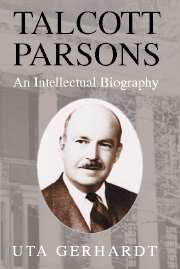Book contents
- Frontmatter
- Contents
- Preface
- 1 Understanding The Structure of Social Action
- 2 Parsons's Sociology of National Socialism, 1938–1945
- 3 The Harvard Social-Science War Effort and The Social System
- 4 A New Agenda for Citizenship: Parsons's Theory and American Society in the 1960s
- Epilogue: A Life of Scholarship for Democracy
- Biblography
- Name Index
- Subject Index
- Plate section
1 - Understanding The Structure of Social Action
Published online by Cambridge University Press: 09 October 2009
- Frontmatter
- Contents
- Preface
- 1 Understanding The Structure of Social Action
- 2 Parsons's Sociology of National Socialism, 1938–1945
- 3 The Harvard Social-Science War Effort and The Social System
- 4 A New Agenda for Citizenship: Parsons's Theory and American Society in the 1960s
- Epilogue: A Life of Scholarship for Democracy
- Biblography
- Name Index
- Subject Index
- Plate section
Summary
Introduction
Parsons's first major opus, The Structure of Social Action, did not become a classic of sociology when it first appeared in 1937. Although it was reviewed in both The American Journal of Sociology and the newly established American Sociological Review, and even featured in the widely read The Saturday Review of Literature, such recognition did not produce much acclaim for the book.
The review in The Saturday Review of Literature entitled “Is Homo Sapient?” an essay by Robert Bierstedt, who was then based at Columbia University's Department of Philosophy, addressed Parsons as “a young Heidelberg-trained sociologist at Harvard”. Bierstedt found the book opposed to an objective empiricist approach, which, he said, presumably made it unlikely that “such hard-headed empiricists as the authors of ‘Middletown in Transition’ would bother to read The Structure of Social Action“. In his view, it proposed a subjective approach which was “the ‘voluntaristic theory of action’ growing out of … theoretical convergence” that claimed to be able to “give sociology a well-defined field of its own”.
Bierstedt did not recommend Parsons's book. He could not see in it an answer to the problems of sociology, let alone a “charter for sociology” as it would be hailed at the end of the 1980s, on the occasion of the fiftieth anniversary of its publication. In the late 1930s, Structure appeared to Bierstedt, who himself had studied with Parsons, a far from satisfactory solution.
- Type
- Chapter
- Information
- Talcott ParsonsAn Intellectual Biography, pp. 1 - 57Publisher: Cambridge University PressPrint publication year: 2002
- 2
- Cited by

